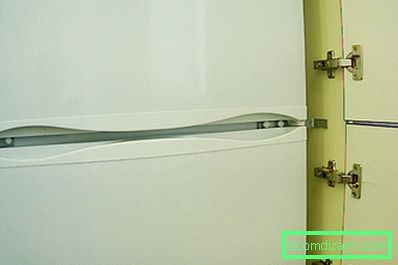How to build a regular refrigerator in a headset
This article is dedicated to all those who are interested in the question: is it possible to make a regular refrigerator built-in? We answer immediately - you can, even if the door is convex, and you are not a professional furniture maker.
Is it worth it to build a regular refrigerator in the headset?
The reasons for the refusal to buy built-in equipment in favor of self-embedding an ordinary model can be several:
- The built-in model is always more expensive;
- Other things being equal, the built-in device is inferior in volume and capacity;
- It's just that the house already has an excellent old refrigerator.
On the other hand, to build in a built-in refrigerator from a technical point of view is much more reliable, simpler, and the appearance of the entire design, from the fittings to the facades in this case, is ideal. Built-in refrigerator does not overheat, less noise and vibrates.
But if you still remain true to the idea of building a refrigerator in the kitchen set, we suggest that you consider two ways how to do it:
- Method 1. Install the refrigerator in a box (case-pencil case), designed according to its dimensions, and hang the doors of the cabinet's facades.

An ordinary refrigerator built into the cupboard-pencil case
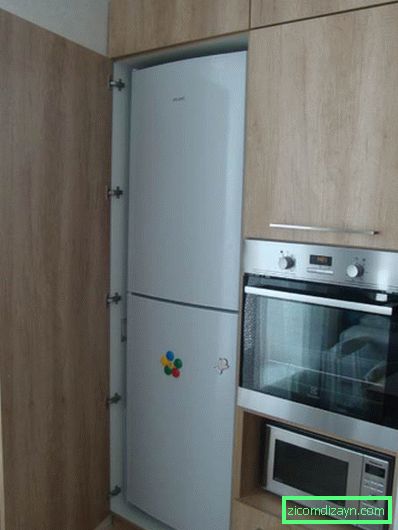
The option of installing a conventional refrigerator without connecting facades with doors
- Method 2. Disguise the refrigerator with a dyeing or self-adhesive material (photo-ideas are presented at the end of the article).
See also: 10 criteria for choosing a refrigerator, which you need to know before buying
Method 1. How to build a regular refrigerator in the cabinet
To embed a non-built-in refrigerator in the finished pencil case you will need:
- Ball guides full extension in the half width of the front of the cabinet (2 pcs.);
- Corners metallic (4 pcs.);
- Elements of fastening (screws, bolts with nuts, screws);
- Drill and quality drills for metal of the desired diameter;
- Pencil;
- Ruler;
- Level.

This is how the full-extension ball guide looks
To make the frame and facades of the pencil case with your own hands (or the hands of a professional furniture maker) you will need:
- MDF or chipboard thickness of 16 mm (selected taking into account the design of the kitchen, ie use the same facades);
- Melamine edge in the color MDF / chipboard thickness of 2 mm;
- Furniture loops are desirable with closers and an opening angle of at least 110 degrees so that you can easily reach the inner drawers and shelves of the refrigerator (3-4 loops for a large door and 2-3 for a freezer door);
- Handles for furniture (2 pcs.);
- Self-tapping screws;
- Confirmary furniture;
- Miniclips;
- Corners.
Step 1. We make measurements and design the box for the installation
To build a regular refrigerator in the kitchen, first you need to create a cabinet for him. There are two variants of the development of events: either you are an experienced master and you make a box yourself, or you are an ordinary person and order the manufacture of a pencil case to professionals according to individual size. In the latter case, you only need to directly build a refrigerator in a niche - everyone can do it, following our instructions.
- Ideally, the box for the installation of the refrigerator should be envisaged at the design stage of the kitchen set - so you do not have to bother searching for materials suitable for the furniture available.
Whichever way you choose, first you need to determine the place where the device will stand and make accurate measurements of the future case-pencil case.
- The main principle of determining the dimensions of the frame: around the refrigerator must constantly circulate the air to cool its surface. This means that your cabinet will be somewhat larger than the refrigerator.
The algorithm is as follows:
- We measure the width, height and depth of the refrigerator, as well as the distance from the floor to the middle of the gap between its upper and lower doors.
- We determine the size of the details of the pencil case taking into account technological stocks:
- External width of the cabinet. In it, you need to lay a stock for the installation of loops at least 28 mm. Thus, with a refrigerator width of 600 mm and a thickness of two sidewalls of a 16 mm box, the outer width of the cabinet is at least 660 mm.
- Height of the pencil case. It is chosen at your discretion, but ideally the pencil case should be on a level with the hanging cabinets of the headset. That is, if the kitchen has a height of 216 cm, then the pencil case, and therefore the frame racks should have a height of 216 cm. In such a high pencil case above the refrigerator there will be a shelf - it will be needed both for ventilation and for storage of things.
Important note: in the height of the refrigerator niche, it is necessary to lay a gap of at least 5 cm for ventilation.
- Racks. In the size of the sidewalls we lay a stock of at least 50 mm, which means that if the depth of the refrigerator is 600 mm, the posts of the box must have a width of 650 mm.
- Panel over the refrigerator (shelf). Its width is calculated by the formula: the outer width of the pencil is minus the sum of the thicknesses of the two racks (for example, 660-16-16 = 628 mm). But the length of the shelf should be less than the width of the rack by about 100 mm - then the panel will not reach the wall and cover the rear of the refrigerator, which is necessary for ventilation. If this is not done, the device will simply overheat. Thus, we consider: 650-100 = 550 mm.
- The top panel of the box (cover). If you plan to make a storage niche above the refrigerator, then you can make the top cover deaf (for example, 628 × 650 mm), but at the same time you will have to install a vent in its back. The second option: just make the top cover, not reaching the wall by 10 cm. Then we assume: 650-100 = 550 mm.
- Rear wall of the shelf. Its width = The inner width of the box (for example, 628 mm). The height of the wall is calculated at your discretion (depending on how high the niche is), but taking into account the two thicknesses of the top cover and the panel above the refrigerator.
- Spacer rear. It should be 150-160 mm wide and equal in length to the inner width of the frame.
- Lower brace (2 pcs.). The width is 50 mm and the length corresponding to the inner width of the frame.
- The plinth. It should be slightly less than the distance from the floor to the edge of the bottom door of the refrigerator so that the facade can be easily opened. So, for example, at a distance from the floor to the edge of the door 80 mm, the height of the socle can be about 68 mm. The length of the socle is equal to the width of the pencil case.
- Facades (3 pieces (for the lower and upper doors of the refrigerator, and also for the shelf above the x-com) or 2 pieces (if you are building a pencil case without a shelf)). The height and width of the facades should be calculated taking into account the thickness of the edges (2 mm on each side of the part) and the gaps between the facades of 5 mm (they are needed in case of a drawdown of the facades with time). So, for example, a 60-centimeter refrigerator will require facades 656 mm wide (without taking into account the edges).
It is necessary to pay attention to three main points, so that the future refrigerator lasts as long as possible:
- For full cooling, the cabinet should not have a rear part, however, to secure the structure, it is desirable to make several spacers (their dimensions, number and mounting location are indicated above).
- Near the cabinet with the refrigerator should not be placed hob or oven.
Here is the drawing.
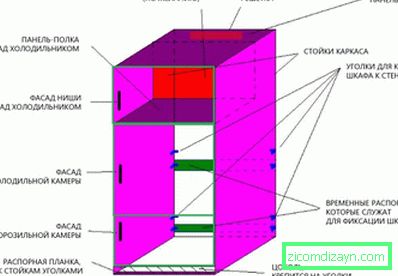
Step 2. We give the materials for sawing and cutting
Now that you know the right dimensions of the pencil case, you can order its manufacture and assembly from a professional master or, if possible, in a company that manufactured or will manufacture your kitchen.
- Perhaps find a furniture maker ready to take on such a non-standard task will not succeed the first time. Therefore, be prepared to familiarize the potential artist with your pencil drawing, calculations and video.
If you manufacture the box yourself, then your next step is to give your lumber for cutting and cutting into a specialized firm.
Step 3. Assemble the frame
At this stage, the finished parts of the pencil case need to be assembled like a designer:
- The top panel and the panel above the refrigerator itself are connected to the minifix stands.
- We fix the shelf and the back wall with confirmations (from below). Also fasten the back wall to the racks with the help of corners.
- On the back of the frame, approximately at the center of the niche of the refrigerator, we also use the corners to attach a spacer with a width of 10-15 cm and a length equal to the inner width of the cabinet. Then lift the frame vertically.
- We attach one more spacer of smaller size to the posts in the lower part of the frame (to the corners).
- We put the skeleton in the place where it should stand, then leveling it in accordance with the level we pull together with the neighboring hanging cabinets and curbstones. For the reliability and rigidity of the structure, we additionally attach the stand to the wall on the corners (approximately at the middle of the case, it is also possible in the lower part).
- We put another spacer in the front lower part of the frame (behind the socle) with the help of corners: one side of the corner is fixed to the post, and the other to the floor.
- We install the hinges for the facades on one of the racks. For the facade of the refrigerating chamber, you can install 4 loops, and for the freezing facade there will be enough and a couple of loops.
- In one of the stands we make a hole for the wire and connect the refrigerator to the socket. Do not forget that the outlet should be at least 30 cm from the floor and not less than 10 cm from the side of the refrigerator. This arrangement is considered safe (and the water will not reach and the wire will not heat up).
Step 4: Install the refrigerator in the box
Hurray, it's time to remove the temporary spacers, unscrew the handle of the refrigerator and push it into the pencil case. Make sure that the closed facades do not rest on the hatch doors. Further it is necessary at the expense of the refrigerator itself to give rigidity to the racks, especially that which does not support anything and holds the facades (this rack will bend inwards and the doors will be mowed). For this we will use corners.
- One side of the corner needs to be screwed to the rack, and the other - in place of the "native" fastening of the refrigerator doors. To do this, unscrew one or two factory bolts, put the corner and again tighten the bolts, moving the corner so that the facades are leveled.

Also, the corner can be secured over the factory mount as shown in the photo below.

Alternative way to install the angle (above the "native" mount)
- Next, attach the second corner to the other rack, after making an accurate markup. Do not be afraid to drill the refrigerator body - this will not affect its operation in any way.
In these photos you can see how the already established corners will look.
Step 5. We fix the facades on the doors of the refrigerator
It's time for the most interesting - fixing the facades on the doors of the refrigerator, so that they open simultaneously. To achieve this we will help a pair of ball guides (regardless of whether the convex door or not!).
- First, determine the location of the guide - it should be installed approximately at the same level with the handle. It turns out that on the large facade the guide will be installed in the lower part, and on the small one - at the top.
- Stepping away from the edge of the facade about 3 cm, draw a straight line (using the building level) with a pencil equal to the length of the guide.

- Install the first part of the guide (see photo above) by screwing the screws into the mounting holes, then insert the second part of the guide into it.
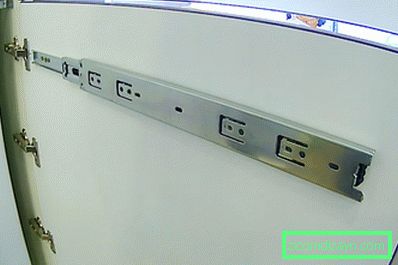
- Install one side of the corner on the outer edge of the movable rail with bolts and nuts.
- The second end of the corner is screwed onto the end of the refrigerator door with a screwdriver and a press-cup, after making the marking. If necessary, you can use two corners (for the rail and the hatch door), and then connect them with a screw as shown in the photo below. If the façade opens slightly incorrectly, its position needs to be adjusted by displacing the corner. That's all, it remains to repeat the same actions with the second door.

Method 2. Simulate the built-in refrigerator with a decor
The first method was for those who are not afraid of manual labor and mathematical calculations. But to harmoniously fit the refrigerator into the interior and create the illusion of the built-in refrigerator you can and decorating ways:
- Staining with enamel paint in the tone of the headset or wall. Suitable car paint in spray cans or enamel in jars. Before painting, the surface of the refrigerator must be wiped with white spirit and covered with a primer.



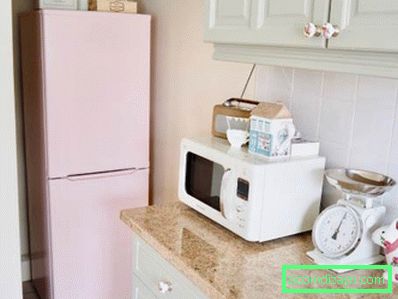
- Painting with acrylic paint using a stencil. Before painting, the surface of the x-k should be wiped with white spirit and covered with a primer. After this, the ornament should be covered with a transparent varnish.


- Vinyl PVC film sticking.

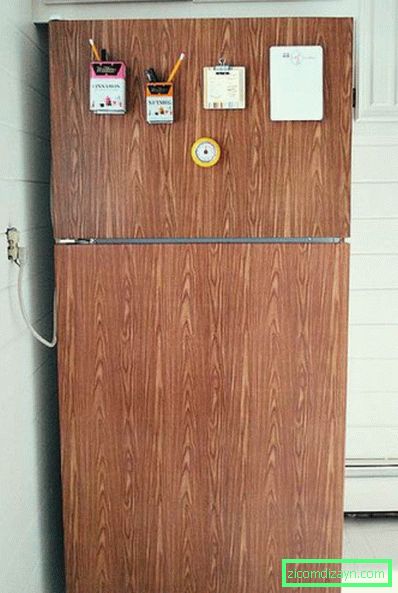

- Mounting of the magnetic chalkboard. Suitable not for every interior, but such a decor instrument will bring and practical benefit - it will be possible to leave notes and draw.

More photo-ideas for reworking refrigerators, as well as step-by-step master classes for their implementation, you can see in the article: 8 ways to decorate the refrigerator.


